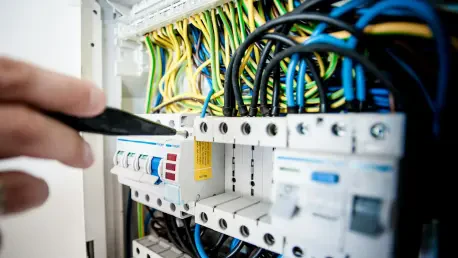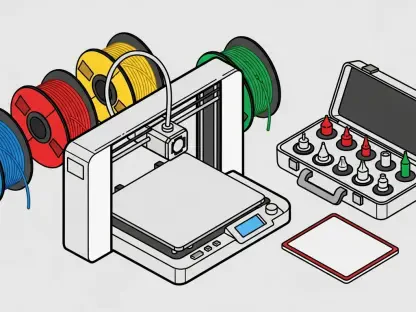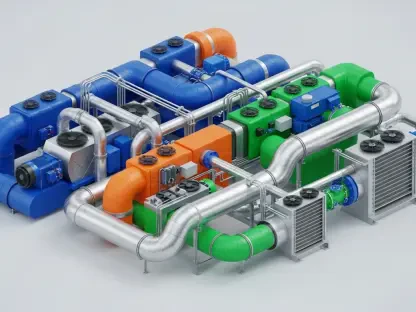The rapid evolution of technology has brought forth innovative solutions that are reshaping how small and medium-sized enterprises (SMEs) manage equipment maintenance, with the Internet of Things (IoT) leading the charge in this transformation. For many SMEs, especially in sectors like manufacturing, logistics, and energy, unexpected equipment failures can lead to severe financial losses, delayed deliveries, and unhappy customers. IoT tools offer a groundbreaking approach by enabling real-time monitoring and predictive analytics to anticipate issues before they escalate. By integrating sensors, data analytics, and artificial intelligence (AI), these tools help businesses shift from a reactive “fix-it-when-it-breaks” mindset to a proactive strategy that minimizes downtime and maximizes efficiency. This article explores the many ways IoT technologies are revolutionizing maintenance practices for SMEs, delving into the shift to predictive maintenance, the power of real-time data, and the scalability of solutions tailored to diverse business needs. The focus remains on how these advancements can empower SMEs to maintain a competitive edge by ensuring operational reliability and reducing unforeseen costs. Through a detailed examination of key features and benefits, the potential of IoT to transform maintenance into a strategic asset becomes clear, paving the way for enhanced productivity and customer satisfaction across industries.
Embracing Predictive Maintenance Through IoT
The transition from reactive to predictive maintenance marks a significant leap forward for SMEs, and IoT tools are at the heart of this shift. Traditionally, businesses have relied on fixing equipment only after a breakdown occurs, often leading to costly downtime and rushed repairs. IoT changes this dynamic by deploying sensors that continuously monitor equipment health, identifying subtle signs of wear or potential failure long before a problem becomes critical. This predictive approach allows maintenance to be scheduled at optimal times, preventing disruptions during peak operational hours. Platforms such as SAP Asset Performance Management and IBM Maximo harness IoT data alongside AI to forecast equipment failures and recommend precise maintenance schedules. For SMEs, this capability is invaluable, as it directly translates to fewer interruptions and more consistent output. The financial impact is substantial, with reduced repair costs and extended equipment lifespan becoming tangible benefits that bolster the bottom line.
Moreover, predictive maintenance powered by IoT offers SMEs a competitive advantage by enhancing reliability in customer-facing operations. In industries where timing is everything, such as manufacturing or logistics, the ability to avoid unexpected halts can be the difference between meeting deadlines and losing contracts. These tools analyze historical and real-time data to estimate the remaining useful life of assets, enabling businesses to plan ahead with confidence. The shift also fosters a culture of prevention rather than reaction, aligning maintenance efforts with broader business goals. By adopting IoT-driven predictive strategies, SMEs can transform a once burdensome task into a streamlined process that supports growth and builds trust with clients through dependable service delivery.
Harnessing Real-Time Monitoring for Immediate Response
Real-time monitoring stands as a cornerstone of IoT’s impact on SME equipment maintenance, providing an unprecedented level of visibility into asset performance. Sensors connected to platforms like Siemens Insights Hub and Microsoft Azure IoT continuously track critical metrics such as temperature, vibration, and pressure, sending instant notifications when anomalies are detected. This immediate feedback loop empowers maintenance teams to address issues before they spiral into major failures, safeguarding operations from costly downtime. For SMEs in high-stakes industries like utilities or energy, where even a brief interruption can have cascading effects, such responsiveness is a game-changer. Real-time data ensures that potential problems are not just identified but acted upon swiftly, maintaining the flow of production and service.
Beyond preventing breakdowns, real-time monitoring through IoT tools enhances decision-making by providing a clear, up-to-the-minute picture of equipment status. This capability allows SMEs to prioritize urgent repairs and allocate resources effectively, especially when manpower or budgets are limited. Unlike traditional maintenance schedules that rely on guesswork or fixed intervals, IoT-driven insights offer precision, ensuring that interventions occur only when necessary. The result is a significant reduction in unnecessary maintenance costs while still preserving asset integrity. For businesses operating critical machinery, this balance of vigilance and efficiency transforms how operational risks are managed, fostering a proactive environment where issues are tackled head-on with minimal impact on daily activities.
Leveraging AI for Smarter Maintenance Decisions
The integration of AI and machine learning with IoT tools brings a new layer of intelligence to equipment maintenance for SMEs, moving beyond basic monitoring to deliver actionable insights. Platforms like C3 AI Reliability utilize advanced algorithms to analyze vast amounts of sensor data, predicting equipment failures with remarkable accuracy and minimizing false alerts that can waste time. This technology also enables risk scoring, helping maintenance teams prioritize tasks based on the severity of potential issues. For SMEs with constrained resources, such precision is a vital asset, ensuring that limited time and funds are directed toward the most pressing needs rather than spread thinly across less critical repairs.
Additionally, AI-driven IoT tools provide prescriptive recommendations, guiding SMEs on the best course of action for each piece of equipment. This goes beyond merely flagging a problem—it offers solutions, such as suggesting specific repairs or adjustments based on data trends. By removing much of the guesswork from maintenance planning, these tools allow even smaller businesses without dedicated technical staff to make informed decisions. The impact on operational efficiency is profound, as maintenance becomes a strategic process rather than a reactive chore. SMEs can optimize their workflows, reduce unnecessary downtime, and focus on core business activities, knowing that their equipment health is backed by data-driven intelligence that anticipates and mitigates risks effectively.
Scaling IoT Solutions to Match Business Growth
One of the standout strengths of IoT maintenance tools is their scalability, accommodating SMEs at various stages of development with tailored solutions. For larger or more complex operations, enterprise-grade platforms like PTC ThingWorx offer robust features, including real-time diagnostics and predictive analytics, ideal for managing extensive asset fleets. Conversely, mobile-first options such as UpKeep and MaintainX cater to smaller businesses with user-friendly interfaces and essential IoT functionalities, making adoption straightforward without overwhelming technical demands. This diversity ensures that SMEs can select a tool that aligns with their current capacity, whether they’re a startup testing the waters or an established firm looking to expand their maintenance capabilities.
Scalability also means that IoT solutions can grow alongside the business, adapting to increasing demands without requiring a complete overhaul. Cloud-based systems like AWS IoT enable SMEs to start with pilot projects, monitoring a handful of assets, and scale up seamlessly as their operations expand. This flexibility is particularly beneficial for businesses in dynamic industries like logistics, where equipment needs can fluctuate. Edge-first platforms further support distributed operations by processing data locally, ensuring reliability even as geographic reach broadens. By investing in scalable IoT tools, SMEs can future-proof their maintenance strategies, avoiding the pitfalls of outgrowing less adaptable systems while maintaining cost efficiency during periods of growth or transition.
Integrating IoT Data with Operational Workflows
A critical advantage of IoT tools lies in their ability to integrate seamlessly with existing operational systems, such as computerized maintenance management systems (CMMS), to streamline maintenance workflows. Platforms like IBM Maximo and Limble CMMS convert raw IoT sensor data into actionable work orders, automating tasks that would otherwise require manual input. This integration ensures that insights gained from monitoring equipment translate directly into scheduled repairs or preventive actions, reducing administrative overhead. For SMEs with limited staff, this automation is a significant benefit, allowing focus to remain on core business functions rather than getting bogged down in paperwork or coordination.
Furthermore, integrating IoT data with workflows enhances visibility across departments, fostering collaboration between maintenance teams and other operational units. When sensor alerts trigger maintenance tasks within a CMMS, managers gain a clearer understanding of asset health and can align maintenance schedules with production needs. This interconnected approach minimizes conflicts, such as scheduling repairs during peak operational times, and optimizes resource allocation. For SMEs, where every hour of downtime can impact revenue, such efficiency is crucial. The ability of IoT tools to bridge the gap between data collection and execution transforms maintenance into a cohesive part of the broader business strategy, driving productivity and ensuring that equipment reliability supports overall goals.
Enhancing Remote Operations with Edge Computing
For SMEs managing equipment in remote or challenging environments, edge computing within IoT tools offers a powerful solution to connectivity constraints. Platforms like SUSE Edge and AWS IoT Greengrass process data locally at the equipment site, minimizing the need for constant cloud connectivity. This is particularly vital for industries such as logistics or energy, where assets may be located in areas with unreliable internet access. By handling data analysis at the edge, these tools ensure faster response times to potential issues, maintaining operational continuity even when communication with central servers is disrupted.
Edge computing also bolsters security and reliability, key concerns for SMEs operating across dispersed locations. Processing data closer to the source reduces the amount of sensitive information transmitted over networks, lowering the risk of breaches. Additionally, local processing ensures that critical maintenance decisions can be made without delay, even in the absence of a stable connection. For businesses with far-flung operations, this capability means that equipment health remains under control regardless of location. IoT tools leveraging edge computing empower SMEs to extend their reach without sacrificing the benefits of real-time monitoring and predictive maintenance, ensuring consistency and efficiency in even the most isolated settings.
Democratizing IoT for Smaller Enterprises
The growing accessibility of IoT tools is leveling the playing field for SMEs, particularly those without extensive technical resources or budgets. Mobile-first platforms like MaintainX offer intuitive interfaces and basic predictive features, making it easier for smaller businesses to adopt IoT without needing specialized IT staff. These tools focus on simplicity, providing essential functionalities such as condition-based alerts and straightforward analytics at a fraction of the cost of enterprise solutions. This democratization of technology allows SMEs to experience the advantages of smarter maintenance without the burden of complex implementation or high upfront investments.
Beyond ease of use, the affordability of these accessible IoT solutions ensures that smaller enterprises can compete with larger counterparts in operational reliability. By starting with cost-effective tools, SMEs can gradually build familiarity with IoT capabilities, laying the groundwork for more advanced systems as their needs evolve. This step-by-step approach mitigates the risk of overcommitting resources early on while still delivering immediate benefits like reduced downtime and better asset management. The trend toward user-friendly IoT platforms reflects a broader industry shift, recognizing that equipping SMEs with practical, scalable technology is essential for fostering innovation and resilience across diverse business landscapes.
Navigating Cost and Functionality Trade-Offs
While IoT tools present transformative opportunities for SMEs, striking a balance between cost and functionality remains a critical consideration. Comprehensive platforms like Siemens Insights Hub deliver cutting-edge features, including digital twin support and advanced edge analytics, ideal for businesses with intricate maintenance needs. However, their higher price points and steeper learning curves can pose challenges for smaller firms with limited budgets or technical expertise. For many SMEs, the investment required for such sophisticated systems may outweigh the immediate benefits, necessitating a careful evaluation of long-term value versus upfront costs.
In contrast, simpler IoT tools like UpKeep provide core monitoring and maintenance capabilities at a more accessible cost, though they may lack the depth required for managing complex or large-scale asset fleets. These solutions cater to SMEs prioritizing ease of adoption over extensive functionality, offering a practical entry point into IoT-driven maintenance. The key for businesses lies in assessing specific operational requirements and growth trajectories to select a tool that aligns with both current capacities and future ambitions. By weighing these trade-offs, SMEs can avoid overextending resources while still harnessing the power of IoT to enhance equipment reliability and operational efficiency in a sustainable manner.
Turning Maintenance into a Strategic Advantage
At its essence, IoT redefines equipment maintenance for SMEs by converting it from a reactive burden into a strategic asset that drives business success. Through the use of sensor data, real-time analytics, and predictive modeling, these tools enable businesses to anticipate equipment issues, drastically cutting down on unexpected downtime. This proactive stance not only preserves financial resources by avoiding emergency repairs but also strengthens customer relationships through consistent service delivery. For SMEs in competitive markets, such reliability becomes a distinguishing factor that sets them apart from rivals still reliant on outdated maintenance methods.
The broader impact of IoT on maintenance extends to fostering a data-driven culture within SMEs, where decisions are informed by insights rather than intuition. Whether through instant alerts that prompt timely interventions or automated workflows that streamline repair processes, IoT tools equip businesses with the means to stay ahead of potential failures. This shift enhances overall operational resilience, allowing SMEs to allocate attention to growth initiatives rather than constant firefighting. By embedding IoT into their maintenance strategies, smaller enterprises can build a foundation of dependability that supports long-term objectives and cements their reputation for quality and efficiency across their respective industries.
Reflecting on IoT’s Lasting Impact on SME Maintenance
Looking back, the integration of IoT tools into SME equipment maintenance proved to be a pivotal shift, fundamentally altering how businesses approached asset management. These technologies enabled countless SMEs to move beyond the limitations of reactive repairs, adopting predictive and data-driven strategies that curtailed downtime and preserved resources. The ability to monitor equipment in real time, coupled with AI insights and scalable solutions, addressed challenges that once seemed insurmountable for smaller firms, leveling the competitive landscape.
As a forward-looking step, SMEs were encouraged to assess their unique needs against the spectrum of IoT tools available, starting with accessible platforms if budgets were tight, and planning for scalability as operations expanded. Exploring pilot projects offered a low-risk way to test the waters, while prioritizing integration with existing systems ensured seamless adoption. The journey with IoT underscored a broader lesson: embracing technology, even incrementally, positioned SMEs to not only safeguard their assets but also to innovate within their industries. This proactive mindset, sparked by IoT’s capabilities, laid the groundwork for sustained growth and adaptability in an ever-evolving business environment.









